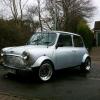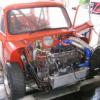What about the guys that have engine conversions and use them on the road, most of them choose 13 inch wheels. I know that's partly for the gearing but surely they wouldnt want 200 hp + if their car wasn't any good at holding the road. 13 inch wheels can be that bad or people would be running narrow tens 10s which are supposed to be best with their engine conversions. The same goes for the z cars lot, I've seen up to 255s on the back with 300 hp on tap. Surely if they didn't handle well on 13s they would switch to 10s, even if they had to have to gearing messed with and final drive ratios made to what they want, because they deffinately have the money to do that if they want after affording a z cars conversion.
You mention 'handling', then you mention 'road-holding'. Do you understand the very basic difference between the two?
The required size of tyre is determined by the weight of the vehicle and this is especially true in the wet. Have you ever driven a really powerful car on ultra-wide tyres in the wet? I have and it is frightening. I used to rally in the old 'works' 240Z Datsuns which had around 250 to 260 bhp. We used 175 section tyres in the wet and 185 in the dry. Car weight in rally trim was around 1250 kg (that's from memory). Tyre testing in the wet was 'exciting' if we used very wide tyres as although the handling was quite good, the road-holding was appalling due to the inability of the tyres to clear the water.
I recently drove a Mini with a 1.8 Honda V-Tec engine and it was, quite simply, horrible. It had 13" wheels with 175/50 tyres and was grossly 'over-tyred'. The owner drove my 'S' on 10" wheels with 165 section tyres and said he wished his car had that sort of road-holding and predictability of handling that mine has.
Ultra-wide tyres do not equal good road-holding - it can be quite the opposite in fact, especially when wet with a light car.
















